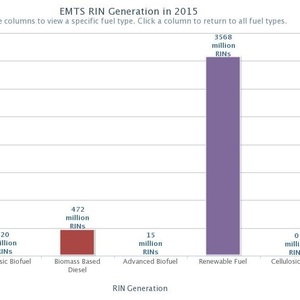EPA: 7.8 million cellulosic RINs generated in March

U.S. EPA
April 21, 2015
BY Erin Krueger
The U.S. EPA has released renewable identification number (RIN) generation data for March, reporting that more than 1.44 billion RINs were generated during the month, including nearly 7.8 million cellulosic RINs.
According to the EPA, 7.8 million D3 cellulosic biofuel RINs were generated in March, bringing the net total for the first three months of the year to 19.73 million. Approximately 19.81 million D3 RINs were generated in total, with 76,942 RIN generation error corrections. EPA data indicates 286,237 D3 RINs were generated for ethanol, with 9.28 million generated for renewable compressed natural gas and 10.25 million for renewable liquefied natural gas. All 19.81 million D3 RINs generated during the first three months of 2015 were generated domestically. No D7 renewable diesel RINs have been generated so far in 2015.
Advertisement
Advertisement
More than 4.83 million D5 advanced biofuel RINs were generated in March, bringing the net total for the first three months of the year to 14.58 million. That number includes 14.89 total D5 RINs that were generated, with a 9,279 RIN error correction. Nearly 6.05 million D5 RINs were generated for ethanol, with 6.18 million generated for naptha, 215,890 generated for heating oil, 2.14 million generated for nonester renewable diesel, and 189 generated for renewable compressed natural gas. During the first quarter of 2015, all 14.59 million D5 RINs were generated domestically.
Nearly 1.24 billion D6 renewable fuel RINs were generated in March, bringing the net total for the first three months of the year to 3.57 billion. To date, the EPA has reported 429,829 in RIN generation error corrections for D6 renewable fuel. The majority of D6 RINs, 3.47 billion, have been generated for ethanol, with 7.37 million generated for biodiesel, and 94.2 million generated for nonester renewable diesel. During the first three months of the year, 3.47 billion D6 RINs were generated by domestically, with 8.01 million generated by importers and 94.2 million generated by domestic entities.
Advertisement
Advertisement
Nearly 191.36 million D4 biomass-based diesel RINs were generated in March, bringing the net total for the first quarter of 2015 to 472.28 million. A total of 472.44 million D4 RINs were generated during the first three months of the year, with a 154,106 RIN generation error correction. Most, 349.69 million, have been generated for biodiesel, with 122.74 million generated for renewable diesel. During the first three months of the year, 394.2 million D4 RINs were generated domestically, with 33.29 million generated by importers and 44.95 million generated by foreign producers.
Of the 4.75 billion RINs generated so far this year, the EPA notes 104.54 million have been retired, with 144.59 million locked and available and 3.83 million unlocked and available.
Related Stories
The U.S. Department of Energy’s Office of Energy Efficiency and Renewable Energy is soliciting public comments on a preliminary plan for determining provisional emissions rates (PER) for the purposes of the 45Z clean fuel production credit.
On July 17, Iowa’s cost-share Renewable Fuels Infrastructure Program awarded $1.12 million in grants for 20 applicants to add B11 and 4 applicants to add E15 to retail sites. This was the first meeting following the start of RFIP’s fiscal year.
Par Pacific Holdings Inc., Mitsubishi Corp. and ENEOS Corp. on July 21 announced the signing of definitive agreements to establish Hawaii Renewables LLC, a joint venture to produce renewable fuels at Par Pacific’s refinery in Kapolei Hawaii.
A new study published by the ABFA finds that the U.S. EPA’s proposal to cut the RIN by 50% for fuels made from foreign feedstocks, as part of its 2026 and 2027 RVOs, could stall the growth of the biomass-based diesel (BBD) industry.
Reps. Mike Flood, R-Neb., and Troy A. Carter, Sr., D-La., on July 21 reintroduced the SAF Information Act. The bill directs the U.S. EIA to more explicitly include SAF data in its weekly and monthly reports.
Upcoming Events










